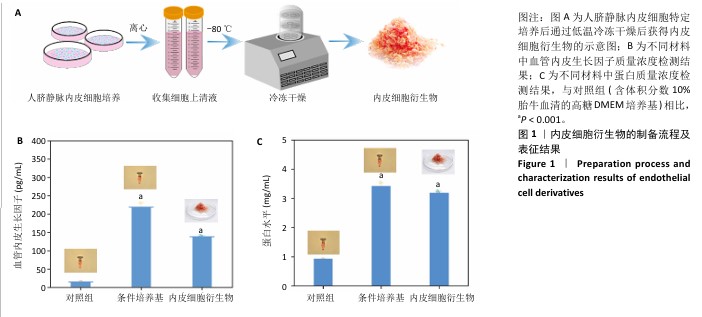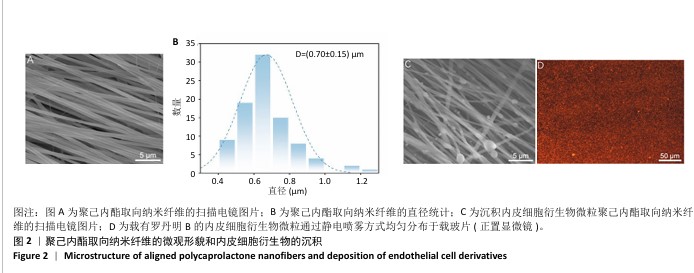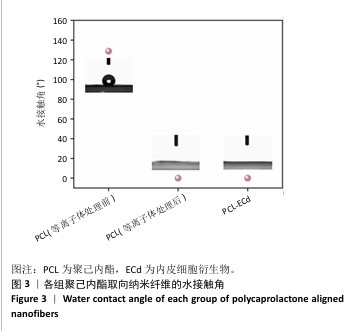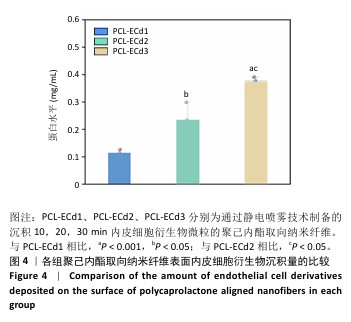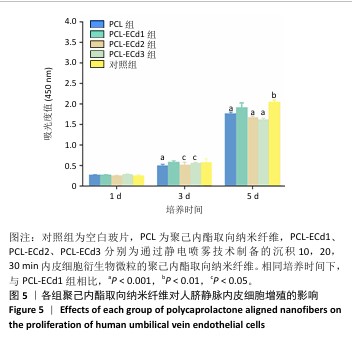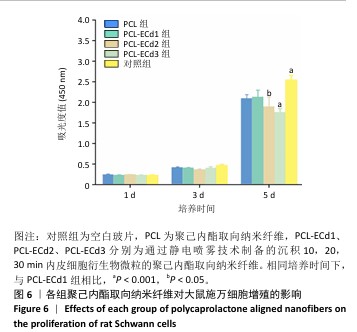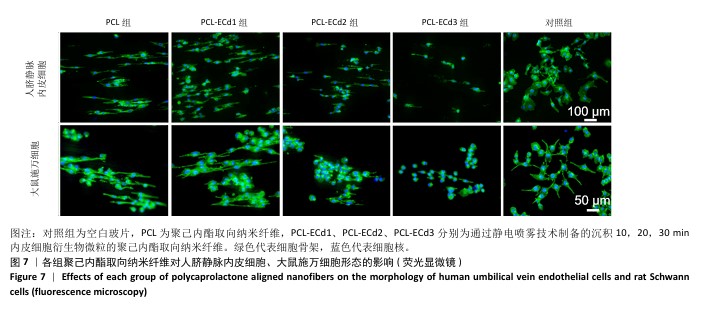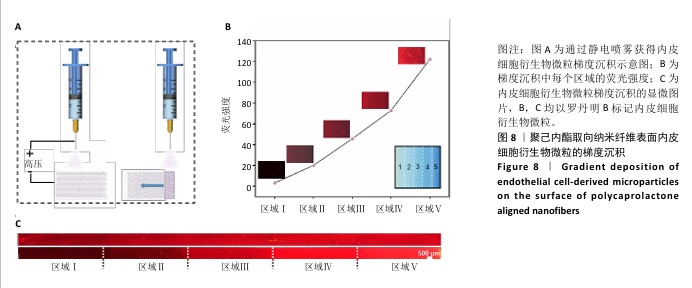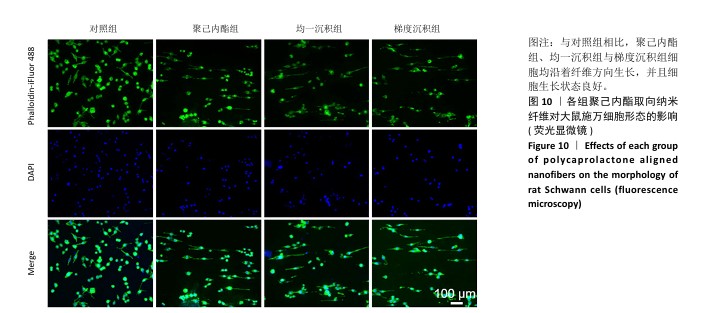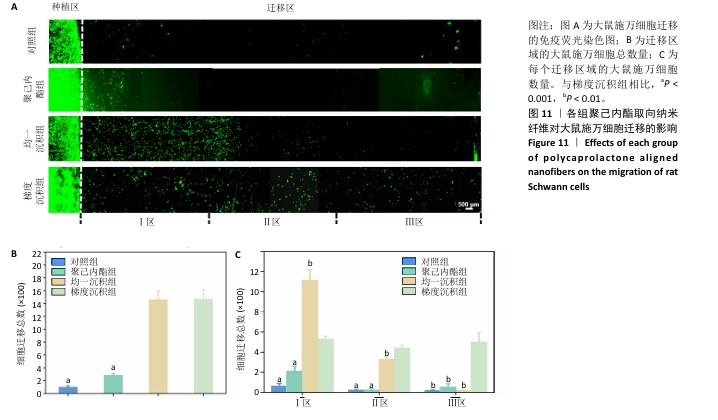[1] SHARIFI M, KAMALABADI-FARAHANI M, SALEHI M, et al. Recent advances in enhances peripheral nerve orientation: the synergy of micro or nano patterns with therapeutic tactics. J Nanobiotechnology. 2024;22:194.
[2] WANG X, CHEN S, CHEN X, et al. Biomimetic multi-channel nerve conduits with micro/nanostructures for rapid nerve repair. Bioact Mater. 2024;41:577-596.
[3] XUE J, WU T, LI J, et al. Promoting the Outgrowth of Neurites on Electrospun Microfibers by Functionalization with Electrosprayed Microparticles of Fatty Acids. Angew Chem Int Ed Engl. 2019;58:3948-3951.
[4] HAN Q, GUAN W, SUN S, et al. Anisotropic topological scaffolds synergizing non-invasive wireless magnetic stimulation for accelerating long-distance peripheral nerve regeneration. Chem Eng J. 2024;496:153809.
[5] JIN B, YU Y, LOU C, et al. Combining a Density Gradient of Biomacromolecular Nanoparticles with Biological Effectors in an Electrospun Fiber-Based Nerve Guidance Conduit to Promote Peripheral Nerve Repair. Adv Sci (Weinh). 2023;10:e2203296.
[6] MOTTA CMM, ENDRES KJ, WESDEMIOTIS C, et al. Enhancing Schwann cell migration using concentration gradients of laminin-derived peptides. Biomaterials. 2019;218:119335.
[7] WU P, TONG Z, LUO L, et al. Comprehensive strategy of conduit guidance combined with VEGF producing Schwann cells accelerates peripheral nerve repair. Bioact Mater. 2021;6:3515-3527.
[8] CERQUEIRA SR, LEE YS, CORNELISON RC, et al. Decellularized peripheral nerve supports Schwann cell transplants and axon growth following spinal cord injury. Biomaterials. 2018;177:176-185.
[9] HUANG Y, YE K, HE A, et al. Dual-layer conduit containing VEGF-A - Transfected Schwann cells promotes peripheral nerve regeneration via angiogenesis. Acta Biomater. 2024;180:323-336.
[10] MA T, HAO Y, LI S, et al. Sequential oxygen supply system promotes peripheral nerve regeneration by enhancing Schwann cells survival and angiogenesis. Biomaterials. 2022;289:121755.
[11] TANG J, WU C, CHEN S, et al. Combining Electrospinning and Electrospraying to Prepare a Biomimetic Neural Scaffold with Synergistic Cues of Topography and Electrotransduction. ACS Appl Bio Mater. 2020; 3:5148-5159.
[12] XUE J, PISIGNANO D, XIA Y. Maneuvering the Migration and Differentiation of Stem Cells with Electrospun Nanofibers. Adv Sci (Weinh). 2020;7:2000735.
[13] JI E, SONG YH, LEE JK, et al. Bioadhesive levan-based coaxial nanofibrous membranes with enhanced cell adhesion and mesenchymal stem cell differentiation. Carbohydr Polym. 2025;354:123337.
[14] QIAN J, LIN Z, LIU Y, et al. Functionalization strategies of electrospun nanofibrous scaffolds for nerve tissue engineering. Smart Mater Med. 2021;2:260-279.
[15] LI Y, GE Z, LIU Z, et al. Integrating electrospun aligned fiber scaffolds with bovine serum albumin-basic fibroblast growth factor nanoparticles to promote tendon regeneration. J Nanobiotechnology. 2024;22:799.
[16] WANG Q, ZHANG S, JIANG J, et al. Electrospun radially oriented berberine-PHBV nanofiber dressing patches for accelerating diabetic wound healing. Regen Biomater. 2024;11:rbae063.
[17] ZHOU Z, LIN Y, LIU N, et al. Gradient coating of extracellular matrix derived from endothelial cells on aligned PCL nanofibers for rapid endothelialization. Front Bioeng Biotechnol. 2024;12:1527046.
[18] ZHANG X, GUO M, GUO Q, et al. Modulating axonal growth and neural stem cell migration with the use of uniaxially aligned nanofiber yarns welded with NGF-loaded microparticles. Mater Today Adv. 2023;17: 100343.
[19] XUE J, WU T, QIU J, et al. Accelerating Cell Migration along Radially Aligned Nanofibers through the Addition of Electrosprayed Nanoparticles in a Radial Density Gradient. Part Part Syst Charact. 2022;39(4):2100280.
[20] BLACK BJ, ECKER M, STILLER A, et al. In vitro compatibility testing of thiol-ene/acrylate-based shape memory polymers for use in implantable neural interfaces. J Biomed Mater Res A. 2018;106:2891-2898.
[21] XUE J, WU T, QIU J, et al. Promoting Cell Migration and Neurite Extension along Uniaxially Aligned Nanofibers with Biomacromolecular Particles in a Density Gradient. Adv Funct Mater. 2020;30(40):2002031.
[22] WU T, XUE J, LI H, et al. General Method for Generating Circular Gradients of Active Proteins on Nanofiber Scaffolds Sought for Wound Closure and Related Applications. ACS Appl Mater Interfaces. 2018;10:8536-8545.
[23] DAI Y, LU T, LI L, et al. Electrospun Composite PLLA-PPSB Nanofiber Nerve Conduits for Peripheral Nerve Defects Repair and Regeneration. Adv Healthc Mater. 2024;13:e2303539.
[24] PATEL DK, WON SY, JUNG E, et al. Recent progress in biopolymer-based electrospun nanofibers and their potential biomedical applications: A review. Int J Biol Macromol. 2025;293:139426.
[25] ROBLES KN, ZAHRA FT, MU R, et al. Advances in Electrospun Poly(ε-caprolactone)-Based Nanofibrous Scaffolds for Tissue Engineering. Polymers (Basel). 2024;16(20):2853.
[26] SNYDER Y, TODD M, JANA S. Substrates with Tunable Hydrophobicity for Optimal Cell Adhesion. Macromol Biosci. 2024;24:e2400196.
[27] KIM K, YANG J, LI C, et al. Anisotropic structure of nanofiber hydrogel accelerates diabetic wound healing via triadic synergy of immune-angiogenic-neurogenic microenvironments. Bioact Mater. 2025;47:64-82.
[28] LIU H, PUIGGALÍ-JOU A, CHANSORIA P, et al. Filamented hydrogels as tunable conduits for guiding neurite outgrowth. Mater Today Bio. 2025;31:101471.
[29] LIU S, SIMIŃSKA-STANNY J, YAN L, et al. Bioactive ECM-mimicking nerve guidance conduit for enhancing peripheral nerve repair. Mater Today Bio. 2024;29:101324.
[30] GRASMAN JM, KAPLAN DL. Human endothelial cells secrete neurotropic factors to direct axonal growth of peripheral nerves. Sci Rep. 2017;7: 4092.
[31] ZHOU Z, LIU N, ZHANG X, et al. Manipulating electrostatic field to control the distribution of bioactive proteins or polymeric microparticles on planar surfaces for guiding cell migration. Colloids Surf B. 2022;209: 112185.
[32] ZHENG T, WU L, SUN S, et al. Co-culture of Schwann cells and endothelial cells for synergistically regulating dorsal root ganglion behavior on chitosan-based anisotropic topology for peripheral nerve regeneration. Burns Trauma. 2022;10:tkac030.
[33] YAO X, XUE T, CHEN B, et al. Advances in biomaterial-based tissue engineering for peripheral nerve injury repair. Bioact Mater. 2025;46: 150-172.
[34] HUANG J, LI J, LI S, et al. Netrin-1-engineered endothelial cell exosomes induce the formation of pre-regenerative niche to accelerate peripheral nerve repair. Sci Adv. 2024;10:eadm8454.
[35] 宋凯凯,张锴,贾龙.周围神经系统损伤的微环境与修复方式[J]. 中国组织工程研究,2021,25(4):651-656.
[36] WEI Y, ZHOU X, LI Z, et al. Genetically Programmed Single-Component Protein Hydrogel for Spinal Cord Injury Repair. Adv Sci (Weinh). 2025; 12(10):e2405054.
[37] NING X, WANG R, LIU N, et al. Three-dimensional structured PLCL/ADM bioactive aerogel for rapid repair of full-thickness skin defects. Biomater Sci. 2024;12:6325-6337.
[38] XU W, WU Y, LU H, et al. Injectable hydrogel encapsulated with VEGF-mimetic peptide-loaded nanoliposomes promotes peripheral nerve repair in vivo. Acta Biomater. 2023;160:225-238.
[39] HUANG J, ZHANG G, LI S, et al. Endothelial cell-derived exosomes boost and maintain repair-related phenotypes of Schwann cells via miR199-5p to promote nerve regeneration. J Nanobiotechnology. 2023;21:10.
[40] XIA B, LV Y. Dual-delivery of VEGF and NGF by emulsion electrospun nanofibrous scaffold for peripheral nerve regeneration. Mater Sci Eng C Mater Biol Appl. 2018;82:253-264.
[41] SENGUPTA S, PARENT CA, BEAR JE. The principles of directed cell migration. Nat Rev Mol Cell Biol. 2021;22:529-547.
[42] IDRISOVA KF, ZEINALOVA AK, MASGUTOVA GA, et al. Application of neurotrophic and proangiogenic factors as therapy after peripheral nervous system injury. Neural Regen Res. 2022;17:1240-1247.
[43] MENEZES R, VINCENT R, OSORNO L, et al. Biomaterials and tissue engineering approaches using glycosaminoglycans for tissue repair: Lessons learned from the native extracellular matrix. Acta Biomater. 2023;163:210-227.
[44] BARIK D, SHYAMAL S, DAS K, et al. Glycoprotein Injectable Hydrogels Promote Accelerated Bone Regeneration through Angiogenesis and Innervation. Adv Healthc Mater. 2023;12:e2301959.
[45] CHU X L, SONG X Z, LI Q, et al. Basic mechanisms of peripheral nerve injury and treatment via electrical stimulation. Neural Regen Res. 2022; 17:2185-2193. |
